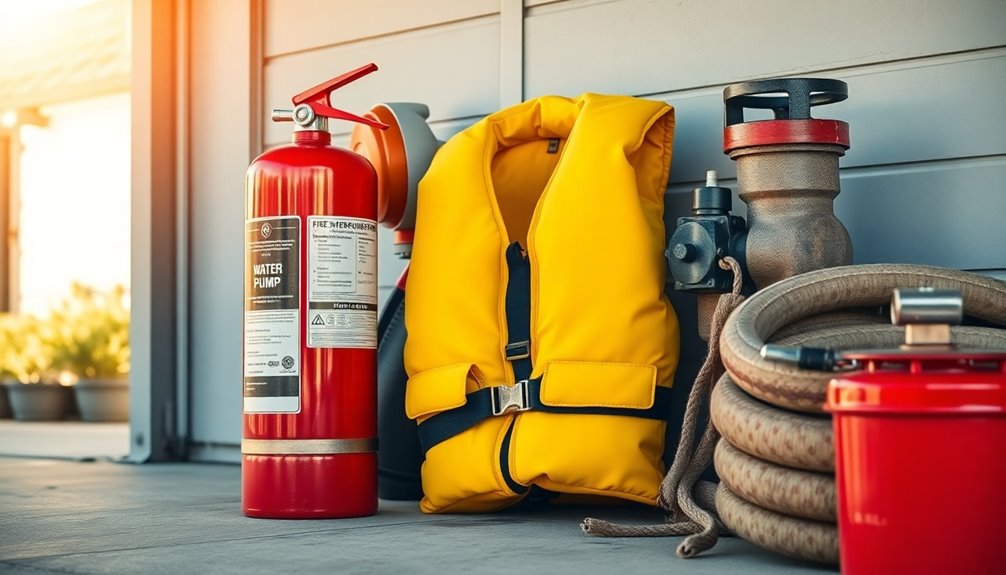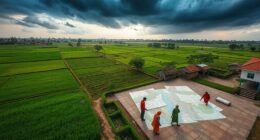Survival knives are essential tools for anyone who enjoys outdoor adventures or needs reliable gear during emergencies. You can find options for every budget—like the affordable Mossy Oak Survival Knife at $20 or the premium Benchmade Raghorn for $420. Look for fixed blade designs, which offer durability and strength, and consider materials like high carbon steel or stainless steel for the best performance. A good knife should fit comfortably in your hand and be easy to maintain. Keep exploring to discover more about the different types of survival knives and the unique features each one offers.
Key Takeaways
- Budget-Friendly Options: Consider the Mossy Oak Survival Knife or Gerber Freeman Guide for reliable performance under $30.
- Mid-Range Choices: The Schrade Frontier 5 and Morakniv Kansbol offer great features and durability for under $50.
- Premium Selections: Invest in high-end knives like the Benchmade Raghorn for top-notch quality and performance, priced around $420.
- Material Matters: Look for high carbon steel blades for edge retention or stainless steel for corrosion resistance, based on your needs.
- Ergonomics & Design: Choose knives with full tang construction and comfortable grips, like G10 or Micarta, for better handling during use.
Overview of Survival Knives

Survival knives are essential tools that can make a significant difference in outdoor situations. You’ll find them invaluable for tasks like shelter building, game skinning, and splitting firewood. In addition to survival knives, survival axes are also important tools to have in outdoor situations. They are great for tasks like chopping wood, clearing brush, and even self-defense. Both survival knives and axes can be a crucial part of any outdoor survival kit.
When choosing a survival knife, consider fixed blade options; they offer unmatched durability and reliability in emergencies. A quality survival knife typically has a blade length between 4 to 7 inches, striking a balance between versatility and usability.
Full tang designs enhance strength, ensuring your knife can handle heavy-duty work. Remember, selecting the right survival knife is critical during emergencies, so think about your specific needs and budget.
Having the right tool at your side can mean the difference between success and struggle in the great outdoors.
Key Materials and Construction

When choosing a survival knife, the materials and construction play an essential role in its performance and longevity. Look for high carbon steel for toughness and edge retention, or stainless steel for corrosion resistance. Tang design matters too; full tang knives offer superior strength.
Here's a quick comparison of common materials:
| Material | Benefits |
|---|---|
| High Carbon Steel | Toughness, excellent edge retention |
| Stainless Steel | Corrosion resistance, low maintenance |
| G10 | Ergonomic grip, durability |
| Micarta | Lightweight, moisture-resistant |
| Blade Thickness | 0.17 to 0.25 inches for toughness |
Types of Survival Knives

Choosing the right type of survival knife can make a considerable difference in outdoor situations.
Tactical knives are built for combat, featuring robust grips and serrated edges for quick cutting. If you're focused on outdoor survival tasks, bushcraft knives are your go-to; they excel in carving and wood processing, often made from high carbon steel for easy sharpening.
Specialty knives cater to unique needs, bridging the gap between tactical and bushcraft applications.
When selecting a knife, consider the ideal blade length based on your intended use, as edge geometry determines cutting efficiency.
Don't forget the handle ergonomics, which contribute greatly to your comfort during prolonged use.
Each type serves specific purposes, so choose wisely!
Budget-Friendly Survival Knife Options

For those on a budget, finding a reliable survival knife that doesn't compromise on quality is entirely possible. A few excellent options can meet your needs without breaking the bank.
The Mossy Oak Survival Knife, priced at $20, offers a robust 10-inch stainless steel blade ideal for heavy tasks. If you're willing to spend a bit more, the Schrade Frontier 5 is available for $46.95 and includes a sharpening stone and firesteel for added convenience.
The Morakniv Kansbol, at $41.99, is lightweight with an impressive blade grind. For versatile use, consider the Gerber Freeman Guide at $28.49.
These knives deliver quality performance, proving that you don't need to spend a fortune to equip yourself for outdoor adventures.
Premium Survival Knife Recommendations

Investing in a premium survival knife can greatly enhance your outdoor experience by providing durability and reliability when you need it most. These knives typically feature high-quality materials and construction, guaranteeing they perform well under pressure. Here are some top recommendations:
| Knife Name | Price | Key Features |
|---|---|---|
| Benchmade Raghorn | $420 | Ultralight, excellent edge retention |
| SOG Pillar | $142 | CPM S35VN blade, ergonomic handle |
| Gerber StrongArm | $90 | Fixed blade, versatile mounting options |
These options cater to various preferences and needs, offering you the confidence to tackle any survival situation effectively. Choose wisely to assure your investment serves you well in the wild.
Maintenance and Care Tips

To guarantee your survival knife remains in top condition, regular maintenance is essential.
Start by cleaning your knife after each use to prevent dirt and debris from causing rust. A simple wipe-down with a damp cloth is often enough; however, for tougher grime, use mild soap and water.
Next, sharpen your blade regularly to maintain its cutting efficiency—this assures safety during use.
Store your knife in a dry place, ideally in a clean, dry sheath, to protect it from moisture.
Finally, conduct periodic inspections to check for wear or damage on the blade and handle.
Expert Preferences and Insights

While selecting a survival knife, experts often prioritize durability, versatility, and ergonomic design. They recommend fixed blade options for their strength and reliability in tough situations.
High carbon steel blades are favored for their edge retention, making them easier to sharpen in the field. You'll want a knife with a full tang for enhanced stability and a handle made from materials like G10 or Micarta for a secure grip.
Experts also highlight the importance of blade thickness, generally between 0.17 to 0.25 inches, to withstand demanding tasks. Additionally, they emphasize that a knife's weight and balance play significant roles in comfort during extended use.
Ultimately, understanding these preferences can guide your selection process effectively.
Frequently Asked Questions
What Size Survival Knife Is Best for Beginners?
For beginners, a survival knife with a blade length of 4 to 6 inches is best. It offers versatility for various tasks without being overwhelming, allowing you to build confidence and skill in outdoor scenarios.
Can Survival Knives Be Used for Everyday Tasks?
Yes, you can use survival knives for everyday tasks. They're versatile tools suitable for cutting, carving, and even food preparation. Just make certain you choose a knife that fits comfortably in your hand for maximum control.
How Do I Choose the Right Knife for My Needs?
Choosing the right knife isn't just about features; it's about your unique needs. Consider what tasks you'll tackle, preferred materials, and budget. A well-chosen knife can make all the difference when it matters most.
Are Survival Knives Legal to Carry in All States?
Survival knives aren't legal to carry in all states. You should check your local laws regarding blade length and carry regulations. Some areas have restrictions, so it's best to stay informed before carrying one.
What Are Some Common Misconceptions About Survival Knives?
You might think survival knives are only for emergencies, but they're also practical tools for everyday tasks. Many believe all knives are the same, but quality, design, and purpose greatly impact their effectiveness.
Conclusion
In the wilderness, your survival knife becomes more than just a tool; it's a lifeline, a symbol of your resilience and resourcefulness. By choosing the right knife, you're not just preparing for challenges; you're embracing the spirit of adventure. Whether you opt for a budget-friendly option or a premium blade, remember that your knife is an extension of yourself. Equip it with care, and it'll guide you through the wild, just as your instincts will lead you home.










